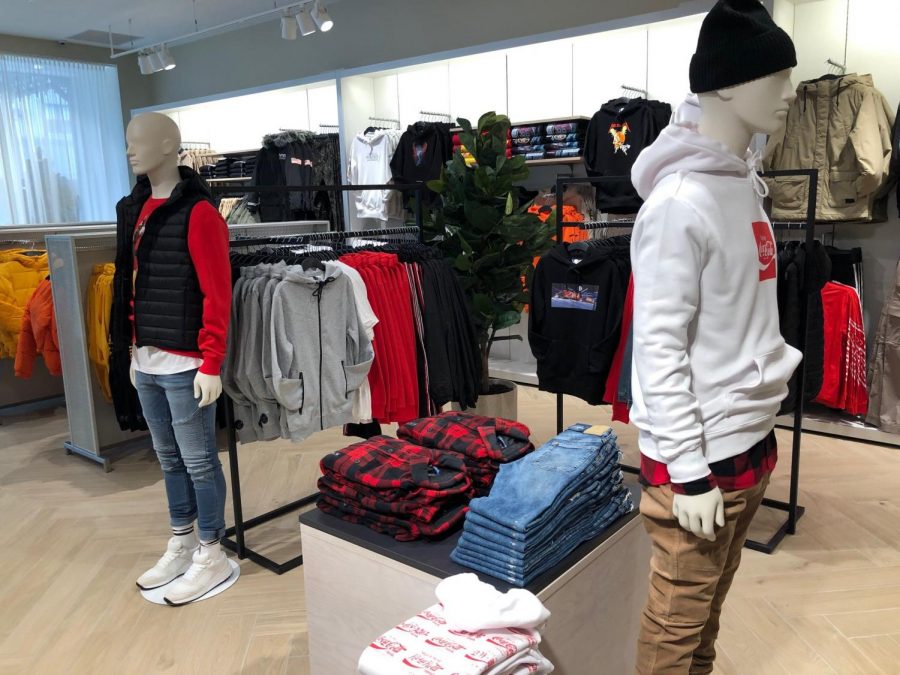Can your clothes change the world?
The Effects of the Fast Fashion Industry.
H&M opens in Downtown Detroit, located at 1505 Woodward Ave., on Thursday, November 21, 2019
September 11, 2020
Everyone wears clothes, in fact I’m sure you have a closet full of them right now. Some you only wear every once in a while, others you wear all the time. What if I told you that the blue t-shirt that just sits in your closet, neglected, took over 650 gallons of water to make. Would you start wearing it?
What is fast fashion?
Fast Fashion takes up 95 percent of the average person’s closet, and 10 percent of the world’s carbon footprint. According to Dictionary.com fast fashion is “low-priced clothing that is brought to market quickly and copies fashion trends created by luxury brands or small, independent designers.” Clothes made by these fast fashion brands are more often than not made in sweatshops. The clothes are pumped out monthly to follow the newest fashion trends. The clothes are usually made with cheaper materials and then the price is higher because people will buy it based on the brand, not the quality. Soon a teenage girl will pick up the item from American Eagle with a Starbucks cup in the other hand, and the rest is history.
According to Goodonyou.eco says, “It plays into the idea that outfit repeating is a fashion faux pas, and that if you want to stay relevant, you have to sport the latest looks as they happen.” Trendy clothes end up at Goodwill in just years, or even months. But before learning what brands should be avoided, it’s important to know why they should be avoided.
The Effects of Fast Fashion
According to The New York Times, when our clothing eventually ends up in landfill, the materials used by fast fashion brands will not decay. Therefore, it’s important to recycle clothing, donate clothing, or buy second hand clothing.
Not only does fast fashion affect the environment, it also affects the economy. Many brands make their clothing in sweatshops. These sweatshops have poor working conditions, low wages, and long hours. They may help people put food on their table, but these jobs won’t result in enough money to buy a house, which leads to no effect on overall poverty.
Who Makes Fast Fashion?
There are a few ways a consumer can spot if a brand they’re looking at is considered fast fashion. Some include:
- Cheap clothing material that often falls apart after a couple of wears
- Limited quantity of certain garments
- Short turnaround time between seeing the item appear in the media and it hitting the shelves
- Hundreds to thousands of different styles that all touch on the latest trends
These clothing brands may not seem so scary from a consumer perspective, but they heavily affect the environment, the workers making the clothing, and even the economy. The best way to avoid fast fashion brands is to be aware of who they are. Some of these brands include:
- Top Shop
- Urban Outfitters
- GAP
- Fashion Nova
- Shein
- Romwe
- H and M
- Hot Topic
- Nasty Gal
- American Eagle
- Old Navy
As long as the majority of people stay away from these brands, carbon footprints can be reduced and clothes that are better quality and better for the environment will come into the spotlight. Another option is to buy second-hand clothing from thrift stores. This is a great way to still follow trends and get overpriced clothing a lot cheaper.
How to Take Down Fast Fashion
Buy less and buy better. This means to splurge on the $40 top if it means getting years of use out of it, rather than buying the $15 top and getting only a year out of it. This helps reduce clothing waste and save money in the long run. People overlook the expensive ethical clothing brands because of their prices, but quality matters when it comes to clothing. Some NOT fast fashion brands include:
- Patagonia
- Boden
- Pact
- Boody
- Ref Jeans
- Rent the Runway
- Reformation
- Levis
- Any local thrift store
Along with these ethical brands there are also rules that can guide consumers when shopping for clothing. Think of how many times the item will be worn after purchasing, if it’s more than thirty, buy it. Don’t shop with the idea that the item can be donated later. Look for materials that can easily be recycled. Shop at a thrift store or swap clothing with friends and family. These guidelines will help consumers avoid and destroy the fast fashion industry. There are so many ways that one person can affect the world, who knew clothing was a part of that. Next time you pass a thrift store or buy from an ethical brand, not only will you feel good in the clothing, but you’ll feel good about it too.




Kaitlyn King • Sep 17, 2020 at 1:15 pm
Brie, I love your article! It brings awareness to a big modern day problem while giving facts and accurate information. I loved how you gave us stores not to shop at and stores we should shop at, so we can actually help make a difference. I will definitely keep this article in mind next time I shop. Thanks for giving us ways to help!!
Ellie • Sep 17, 2020 at 1:04 pm
I never realized how bad fast fashion was! Thanks for educating me, I will avoid it as much as possible.